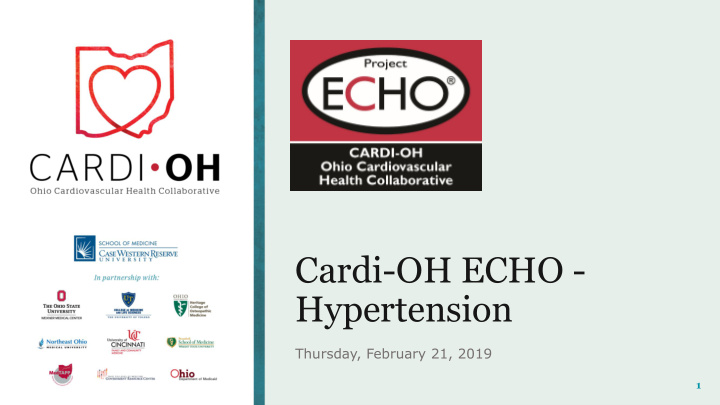



Cardi-OH ECHO - Hypertension Thursday, February 21, 2019 1
Unrecognized Hypertension - Strategies to Improve Diagnosis Rosellen Roche, MD, PhD, FHEA Goutham Rao, MD Chief Clinician Experience and Well-Being Associate Professor of Primary Care Officer, University Hospitals Health System Chair, Research and Scholarly Activities Committee Jack H. Medalie Endowed Professor and Chairman Department of Family Medicine Department of Family Medicine and Ohio University HCOM – Cleveland Community Health Division Chief, Family Medicine, Rainbow Babies and Children’s Hospital Case Western Reserve University School of Medicine & University Hospitals of Cleveland 2
Disclosure Statements The following planners, speakers, moderators, and/or panelists of the CME activity have financial relationships with commercial interests to disclose: • Adam T. Perzynski, PhD reports being co-founder of Global Health Metrics LLC, a Cleveland- based software company and royalty agreements for forthcoming books with Springer publishing and Taylor Francis publishing. • Siran M. Koroukian, PhD reports ownership interests in American Renal Associates, and Research Investigator subcontract support from Celgene Corporation. • George L. Bakris, MD reports partial salary from Bayer as FIDELIO PI, partial salary from Janssen as CREDENCE Steering Committee, partial salary from Vascular Dynamics as Calm-2 Steering Committee, and receiving honorarium as a consultant to Merck, NovoNordisk. • These financial relationships are outside the presented work. All other planners, speakers, moderators, and/or panelists of the CME activity have no financial relationships with commercial interests to disclose. 3
Scope of the problem… • 75 million adults with hypertension. • 48.2% of this population has uncontrolled hypertension. • 36.2% of those with uncontrolled hypertension have no awareness of their hypertension and hence no treatment. 4
A large population where hypertension continues to be unrecognized ? • Workplace populations • Although the aging process is known to be associated with raised BP, pressure changes can go unrecognized in the workforce populations (keeping in mind our workforce population gets older as retirement age increases!) 5
Workplace population? Stress and BP? • In an interesting article (Capriotti et al.2000) published by the American Association of Occupational Health Nurses stress that high blood pressure is a major issue in the workplace. This study examined the prevalence of high normal and hypertensive levels of blood pressure in a convenience sample of 94 volunteer employees from a midsize corporation. Blood pressure and level of reported stress were assessed. Findings revealed rates of 11% and 30% high normal and hypertensive blood pressure levels, respectively. • Importantly, ninety-six percent of participants assumed their blood pressures were normal. • As in other studies, those employees with hypertensive blood pressure reported higher stress levels than normotensive employees. However, the population with high normal BP did not report significantly higher stress levels than normotensive employees. 6
Workplace population? Stress and BP? • Important to remember is that stress causes hypertensive changes in the moment, but stress in the workplace overall leads to habits such as: • high alcohol intake, • increased tobacco use, • lack of exercise due to exhaustion, • unhealthy nutritional habits • There is growing evidence which points to multiple psychological and social factors as contributors to the onset of and trajectory of hypertension. 7
Improving workplace screening? • Occupational health professionals are in the perfect position to test for hypertension amongst employees on a regular basis. CDC (2019) recommendations include: • Periodic blood pressure screening and health risk assessment programs at the worksite through occupational health clinics, health fairs, and other activities can provide blood pressure information to employees. • Lifestyle counseling, either provided at the worksite or covered through employee health insurance plans, can be provided by health care or allied health professionals (i.e., health educators) or by lay health advisors or volunteers. • Blood pressure monitoring devices available for employees to do their own self assessments can also be provided at the worksite with information or training on how to use them. 8
Good practice example? Faculty WellWorks, Ohio University 9
Improving diagnosis in the clinical setting • Among patients with unaware, untreated and uncontrolled hypertension: • 81.8% have health insurance. • 82.5% have a usual source of care. • 61.7% have received care 2 or more times in the past year. 1 0
Why is this happening? • Lessons from pediatric hypertension: • Failure to synthesize past results. • Clinical inertia. • Reluctance to make a definitive diagnosis. 11
Literature 12
Recommendations (Wall et al, JAMA 2014) • Estimate the prevalence of hypertension in your practice: • Overall adults – 29.1% • African Americans – 42.1% • Adults over age 60 – 65% • Query EHR registry on a system-level • Adopt a systematic approach to assess patients identified as potentially having hypertension (Rakotz et al, Chicago). 13
THANK YOU 14
Recommend
More recommend